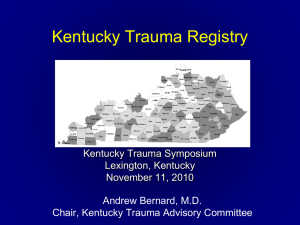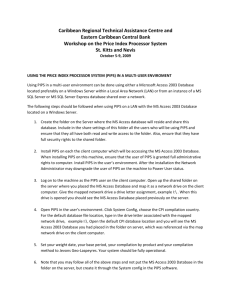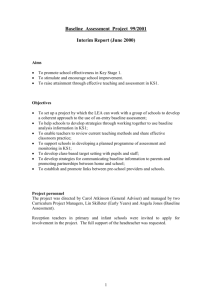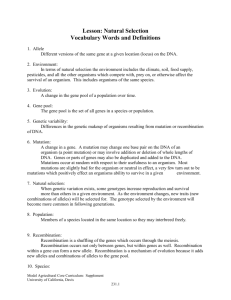Blunt Abdominal Trauma - University of Kentucky | Medical Center
advertisement
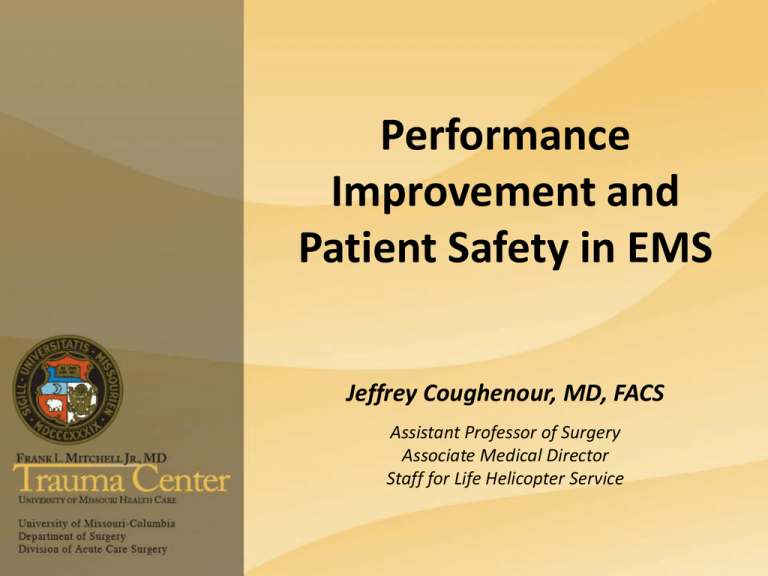
Performance Improvement and Patient Safety in EMS Jeffrey Coughenour, MD, FACS Assistant Professor of Surgery Associate Medical Director Staff for Life Helicopter Service Objectives • Define performance improvement and patient safety (PIPS) • What are the components of a successful system? • What prohibits development? • Demonstrate the positive impact a mature PI process can have on patient care Health Care • “...More with less and doing it better and faster” • Pay for performance initiatives gaining ground but lacking detail • EMS as a component of the continuum of care Health Care PIPS Defined A continuous, multidisciplinary effort to measure, evaluate, and improve the process of care and its outcome. A major objective is to reduce inappropriate variation in care and to improve patient safety. PIPS Defined • Quality (PI) – Indications for early transfusion in transient responder after trauma • Safety (PS) – Accurate type and crossmatch • Combined elements (PIPS) – Transfusion-related acute lung injury (TRALI) Historical Perspective • • • • Quality assurance – retrospective chart review Total quality management… Continuous quality improvement… Performance improvement “Bureaucratic pencil-pushing peckerheads” —P. Kearney Modern PIPS • Continuous cycle of monitoring • Support by reliable method of data collection, obtains valid and objective information • Multidisciplinary review defines corrective strategies • Effect of change is documented as cycle repeats Program Configuration • Administrative accountability – Empower the program to address issues that involve multiple disciplines – Approval from governing body – Adequate administrative support – Defined lines of authority or responsibility Program Configuration • Medical direction – Leadership – Title 202 KAR Chapter 7, Section 801: Developing, implementing, and maintaining a quality improvement program for continuous system and patient care improvement • Program manager – Critical component, logistics Outcome Measurement? • Patient – Complete and rapid recovery • Administrator and payer – Cost of care • Service director or regional physicians – Quality of care “Value Equation” Concept • System variables to individual performance • Increase value by: Improved process or outcome, decrease cost Quality of Process+Quality of Outcome Value = Cost Process Measures • Consensus, local or regional guidelines, or, ideally… nationally derived, evidence-based guidelines Compliance with guidelines, appropriateness of destination determination, delay in assessment, delay in diagnosis, delay in treatment, error in judgment, error in treatment, error in communication, appropriateness of documentation, insurance carrier denials, dispatch time, chute time, response time, scene time, transport time, system skill performance, individual skill proficiency Outcome Measures • Are care processes adequate to achieve the desired outcome? Mortality, morbidity (any derivation from normal health that may be result of a complication or may be pre-existing), pain control, tranfusion-related acute lung injury, ARDS, coagulopathy, hypothermia, did patients whose complaint warranted ALS services receive it, did patients with a breathing problem or respiratory distress receive supplemental oxygen in a timely fashion Data Collection • Should be valid and objective • Participation in a regional trauma registry, at a minimum • State trauma registry preferred • Develop occurrence tracking form – Concerns brought forth from variety of sources Review • Review performance and safety of your EMS system • Is the issue open or closed? • System or individual? • Preventable or not? • Now what? Corrective Action • • • • • • Develop or revise a guideline Targeted education Enhanced resources, communication Counseling Change in provider privileges or credentials External review Results • Demonstrate that a corrective action has the desired effect by continued evaluation • Continuous use of your new PIPS process is more important than “loop closure” Chapter 16, Performance Improvement and Patient Safety, Resources for the Optimal Care of the Injured Patient 2006 Copyright © 2006 American College of Surgeons, Chicago, IL Missouri • 19 CSR 30-40.375 – Uniform Data Collection System and Ambulance Reporting Requirements for Ambulance Services – “Emergency, life-threatening runs” • 19 CSR 30-41.010 – Head and Spinal Cord Injury Reporting Requirements Missouri Protection? • Missouri Revised Statutes, Chapter 537 – 537.035 Peer Review Committees – Physician/surgeon, dentist, podiatrist, optometrist, pharmacist, chiropractor, psychologist, nurse, social worker, professional counselor, mental health professional • EMS… no • Strong opposition Kentucky Law • State statutes with protection – Protect participants with immunity and preserve the confidentiality of peer review documents and information • McGuffy v. Hall (1977) “AN ACT relating to health care malpractice claims or insurance” • 1980, “AN ACT relating to the establishment of certificate of need, licensing and regulation of health facilities and health services” Kentucky Law • 1988, “AN ACT relating to health care” and “AN ACT relating to civil actions” • Sweasy v. King’s Daughters Memorial Hospital (1989) • 1990, …”the lack of such protection inhibits open and candid peer review; and there is an urgent need to promote effective peer review for the protection and welfare of the public…” Kentucky Law • Sisters of Charity Health Systems v. Raikes (1999) – Intended only for physicians who sue over poor peer review results – Not for plaintiffs, unfair advantage Kentucky Revised Statutes • Chapter 211.494 Statewide Trauma Care – Section 4. The statewide trauma care director and the advisory committee shall develop and implement… a statewide trauma care program, including but not limited to… (f) Continuing quality assurance and peer review programs Kentucky Revised Statutes • Chapter 211.494 Statewide Trauma Care – Section 6. Data obtained through a trauma registry or other data collected pursuant to KRS 211.490 to 211.496 shall be confidential… Personal identifying information… shall not be subject to discovery… Bottom Line • There is NO peer review protection in Kentucky • Utilization of attorney client privilege • Perform all PIPS work with the collaboration of a recognized patient safety organization Patient Safety Organizations • Established under the “Patient Safety and Quality Improvement Act of 2005” • Organization of peer review activities in concert with a PSO provides protection • Under the doctrine of pre-emption, federal law "trumps" state law • Federal law has yet to be challenged in malpractice actions in Kentucky courts Patient Safety Organizations • Missouri Center for Patient Safety – Collaboration with the Missouri Ambulance Association, funding from the Missouri Foundation for Health (private) • 16 EMS agencies participating in pilot program www.mocps.org • Destination determination • Cardiac arrest resuscitation • Mass casualty incidents Impact of PIPS • Extension of early blood product administration and contemporary shock resuscitation • Failed airway management Resuscitation Practice • Outdated • “… after 2 liters of crystalloid, consider use of uncrossmatched packed red cells in transient or non-responders.” • Average 2.79 liters LR/NS – Average scene and flight time of under 1 hour Pattern Recognition • Exam findings – Decreased mental status from injury or shock – Suspected TBI – Clinical coagulopathy • Laboratory values – – – – INR > 1.5 Base deficit > 6 Hemoglobin < 11 Hypothermia (<96) or hypotension (SBP <90) Pattern Recognition • Trunk, axillary, groin, or neck wounds not controlled by local wound care – Direct pressure – Tourniquet – Hemostatic dressings • Proximal amputation or mangled extremity • Hemoperitoneum with shock • Massive hemothorax – >2000 mL initially or >200 mL per hour for 4 hours Massive Transfusion • April—December – 9 patients – 3 deaths – 1 inappropriate activation – Total product: 116 PRBCs, 65 FFP, 14 platelet pheresis packs, 13 pre-pooled cryo – Average ratio 1.78-2:1 – Only 3 activations occurred within 1 hour of patient arrival Massive Transfusion • Current 8 Jun – 12 patients – 7 deaths – 1 inappropriate data set inclusion – Total product: 229 PRBCs, 158 FFP, 23 platelet pheresis packs, 29 pre-pooled cryo – Average ratio 1.45:1 – Excluding 1 outlier of 144 minutes, average activation time 0:29 (0:10-2:24) What’s Next? • Additional evidence to determine safety, efficacy, optimal PRBC:FFP ratio • Replace crystalloid with non-albumin colloids? • Lyophalized plasma • POC testing for early MTP activation • Expanded use of ultrasound – IRB application for pneumothorax/ETT position evaluation Airway Management • Increasing number of failed field intubations • Reasonable use of rescue devices • Single 3 month period – Facial fractures, no surgical airway attempt – Failed intubation, poor function of rescue device – Unrecognized esophageal intubation – Occluded ETT – Tracheal injury Airway Management • Targeted outreach education – Ground and flight services • Increased use of simulation – Problem recognition – Review of indications for failed airway algorithm – “3-Step Cricothyroidotomy” 3-Step Cricothyroidotomy Summary Points • PIPS is a labor intensive process • Obtain administrative support • Medical director leadership, which may require partnering with a regional referral center • Logistics is local Summary Points • • • • • Data collection can be difficult Participate in regional or statewide registry Review and make corrective actions Continuous cycle evaluates effectiveness Utilize attorney client privilege or PSOs for legal protection PIPS References • Resources for the Optimal Care of the Injured Patient 2006, Copyright © 2006, American College of Surgeons, Chicago, IL • Missouri State Legislature, www.moga.mo.gov • Kentucky State Legislature, www.lrc.ky.gov • Paula Holbrook, RN, BHS, JD, Clinical Risk Manager, UK Health Care • Richard A. Setterberg Co., LPA

